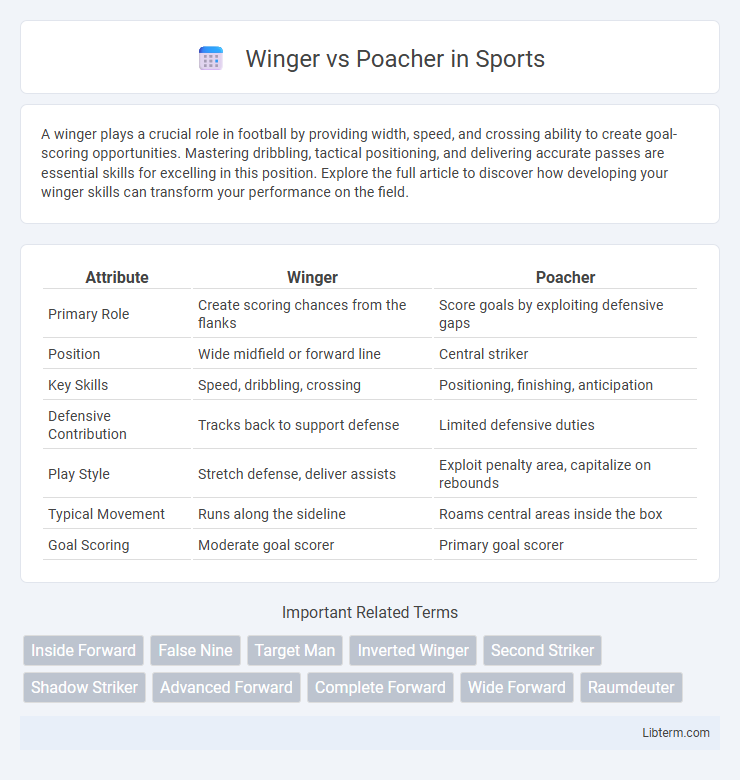A winger plays a crucial role in football by providing width, speed, and crossing ability to create goal-scoring opportunities. Mastering dribbling, tactical positioning, and delivering accurate passes are essential skills for excelling in this position. Explore the full article to discover how developing your winger skills can transform your performance on the field.
Table of Comparison
| Attribute | Winger | Poacher |
|---|---|---|
| Primary Role | Create scoring chances from the flanks | Score goals by exploiting defensive gaps |
| Position | Wide midfield or forward line | Central striker |
| Key Skills | Speed, dribbling, crossing | Positioning, finishing, anticipation |
| Defensive Contribution | Tracks back to support defense | Limited defensive duties |
| Play Style | Stretch defense, deliver assists | Exploit penalty area, capitalize on rebounds |
| Typical Movement | Runs along the sideline | Roams central areas inside the box |
| Goal Scoring | Moderate goal scorer | Primary goal scorer |
Understanding the Roles: Winger vs Poacher
Wingers primarily operate along the flanks, using speed and dribbling skills to deliver crosses and create scoring opportunities from wide positions. Poachers excel inside the penalty box, relying on positioning, anticipation, and quick finishing to capitalize on scoring chances near the goal. Understanding the distinct roles of a winger versus a poacher is crucial for optimizing team tactics and exploiting defensive weaknesses.
Key Attributes of a Winger
Wingers possess exceptional pace and dribbling skills, enabling them to exploit wide areas and deliver precise crosses into the penalty box. Their ability to maintain close ball control and execute quick changes of direction makes them pivotal in breaking down tight defenses. Vision and stamina are key attributes that allow wingers to support both offensive plays and defensive responsibilities throughout the match.
Key Attributes of a Poacher
A poacher excels in goal scoring with exceptional positioning, sharp reflexes, and a natural instinct to capitalize on rebounds inside the penalty area. Their spatial awareness enables them to navigate tight defenses and find scoring opportunities where others might miss. Clinical finishing, off-the-ball movement, and strong composure under pressure define the key attributes that make a poacher a lethal striker in football.
Tactical Positioning Differences
Wingers typically position themselves wide near the touchlines to stretch the opponent's defense and deliver crosses into the penalty area, exploiting space on the flanks. Poachers operate primarily in and around the six-yard box, focusing on quick reactions and positioning to capitalize on rebounds and close-range scoring opportunities. This tactical difference highlights wingers' role in creating chances from wider areas, while poachers concentrate on finishing plays in central goal-scoring zones.
Contribution to Team Play
Wingers contribute to team play by creating width, delivering crosses, and stretching the opponent's defense, which opens up space for teammates to exploit. Poachers primarily focus on positioning inside the penalty box to capitalize on scoring opportunities, often relying on teammates to supply precise passes or rebounds. While wingers facilitate build-up and chance creation, poachers excel in converting chances into goals, making both roles complementary in attacking strategies.
Impact on Goal Scoring
Wingers increase goal-scoring opportunities by stretching defenses with their pace and crossing ability, creating space for forwards and midfielders to exploit. Poachers maximize goal conversion by specializing in positioning and finishing inside the penalty area, often capitalizing on rebounds and through balls. Both roles complement each other, with wingers providing assists through wide play and poachers focusing on high-percentage scoring chances near goal.
Defensive Responsibilities
Wingers typically have greater defensive responsibilities, including tracking back to support fullbacks and pressing opposition wide players to regain possession. Poachers, primarily focused on goal-scoring inside the penalty area, have minimal defensive duties and often remain forward to capitalize on scoring opportunities. Teams relying on wingers benefit from enhanced defensive coverage on the flanks, while formations utilizing poachers require midfielders and defenders to cover the defensive workload.
Famous Wingers and Poachers in Football History
Iconic wingers like Cristiano Ronaldo and Ryan Giggs revolutionized football with their pace, dribbling, and crossing skills, creating numerous goal-scoring opportunities from the flanks. Legendary poachers such as Gerd Muller and Gary Lineker excelled at positioning and instinctively converting chances inside the penalty area, often being the focal point of attack. These contrasting roles emphasize the winger's creativity and wide play versus the poacher's precision and goal-scoring instincts.
Evolution of Roles in Modern Football
Wingers have evolved from traditional touchline-bound playmakers into versatile attackers adept at cutting inside and creating scoring opportunities, reflecting modern tactical fluidity. Poachers, once primarily goal-focused strikers, now often contribute to build-up play and pressing, adapting to high-press systems in contemporary football. The evolution highlights a shift towards multifunctional roles emphasizing adaptability, spatial awareness, and team dynamics.
Choosing the Right Player for Your System
Selecting between a winger and a poacher depends on your team's tactical setup and playing style. Wingers excel in wide areas, providing pace, crosses, and width to stretch defenses, ideal for systems emphasizing wing play and creating chances from the flanks. Poachers thrive in central positions with a focus on goal-scoring inside the box, making them crucial for systems that rely on quick, clinical finishes and exploiting defensive lapses in the penalty area.
Winger Infographic

 libterm.com
libterm.com